您好,登錄后才能下訂單哦!
您好,登錄后才能下訂單哦!
這篇文章將為大家詳細講解有關Java多線程并發生產者消費者設計模式的示例分析,小編覺得挺實用的,因此分享給大家做個參考,希望大家閱讀完這篇文章后可以有所收獲。
一、兩個線程一個生產者一個消費者
需求情景
兩個線程,一個負責生產,一個負責消費,生產者生產一個,消費者消費一個。
涉及問題
同步問題:如何保證同一資源被多個線程并發訪問時的完整性。常用的同步方法是采用標記或加鎖機制。
wait() / nofity() 方法是基類Object的兩個方法,也就意味著所有Java類都會擁有這兩個方法,這樣,我們就可以為任何對象實現同步機制。
wait()方法:當緩沖區已滿/空時,生產者/消費者線程停止自己的執行,放棄鎖,使自己處于等待狀態,讓其他線程執行。
notify()方法:當生產者/消費者向緩沖區放入/取出一個產品時,向其他等待的線程發出可執行的通知,同時放棄鎖,使自己處于等待狀態。
代碼實現(共三個類和一個main方法的測試類)
Resource.java
package com.demo.ProducerConsumer;
/**
* 資源
* @author lixiaoxi
*
*/
public class Resource {
/*資源序號*/
private int number = 0;
/*資源標記*/
private boolean flag = false;
/**
* 生產資源
*/
public synchronized void create() {
if (flag) {//先判斷標記是否已經生產了,如果已經生產,等待消費;
try {
wait();//讓生產線程等待
} catch (InterruptedException e) {
e.printStackTrace();
}
}
number++;//生產一個
System.out.println(Thread.currentThread().getName() + "生產者------------" + number);
flag = true;//將資源標記為已經生產
notify();//喚醒在等待操作資源的線程(隊列)
}
/**
* 消費資源
*/
public synchronized void destroy() {
if (!flag) {
try {
wait();
} catch (InterruptedException e) {
e.printStackTrace();
}
}
System.out.println(Thread.currentThread().getName() + "消費者****" + number);
flag = false;
notify();
}
}Producer.java
package com.demo.ProducerConsumer;
/**
* 生產者
* @author lixiaoxi
*
*/
public class Producer implements Runnable{
private Resource resource;
public Producer(Resource resource) {
this.resource = resource;
}
@Override
public void run() {
while (true) {
try {
Thread.sleep(10);
} catch (InterruptedException e) {
e.printStackTrace();
}
resource.create();
}
}
}Consumer.java
package com.demo.ProducerConsumer;
/**
* 消費者
* @author lixiaoxi
*
*/
public class Consumer implements Runnable{
private Resource resource;
public Consumer(Resource resource) {
this.resource = resource;
}
@Override
public void run() {
while (true) {
try {
Thread.sleep(10);
} catch (InterruptedException e) {
e.printStackTrace();
}
resource.destroy();
}
}
}ProducerConsumerTest.java
package com.demo.ProducerConsumer;
public class ProducerConsumerTest {
public static void main(String args[]) {
Resource resource = new Resource();
new Thread(new Producer(resource)).start();//生產者線程
new Thread(new Consumer(resource)).start();//消費者線程
}
}打印結果:
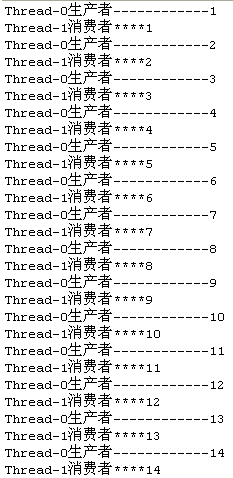
以上打印結果可以看出沒有任何問題。
二、多個線程,多個生產者和多個消費者的問題
需求情景
四個線程,兩個個負責生產,兩個個負責消費,生產者生產一個,消費者消費一個。
涉及問題
notifyAll()方法:當生產者/消費者向緩沖區放入/取出一個產品時,向其他等待的所有線程發出可執行的通知,同時放棄鎖,使自己處于等待狀態。
再次測試代碼
ProducerConsumerTest.java
package com.demo.ProducerConsumer;
public class ProducerConsumerTest {
public static void main(String args[]) {
Resource resource = new Resource();
new Thread(new Producer(resource)).start();//生產者線程
new Thread(new Producer(resource)).start();//生產者線程
new Thread(new Consumer(resource)).start();//消費者線程
new Thread(new Consumer(resource)).start();//消費者線程
}
}運行結果:
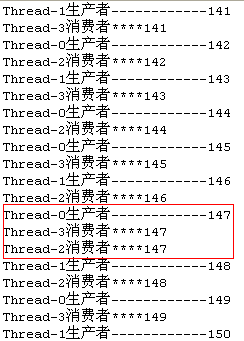
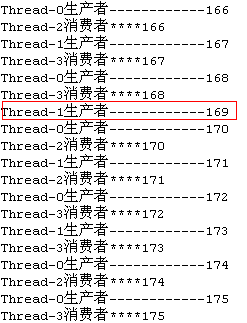
通過以上打印結果發現問題
147生產了一次,消費了兩次。169生產了,而沒有消費。
原因分析
當兩個線程同時操作生產者生產或者消費者消費時,如果有生產者或消費者的兩個線程都wait()時,再次notify(),由于其中一個線程已經改變了標記而另外一個線程再次往下直接執行的時候沒有判斷標記而導致的。if判斷標記,只有一次,會導致不該運行的線程運行了。出現了數據錯誤的情況。
解決方案
while判斷標記,解決了線程獲取執行權后,是否要運行!也就是每次wait()后再notify()時先再次判斷標記。
代碼改進(Resource中的 if -> while)
Resource.java
package com.demo.ProducerConsumer;
/**
* 資源
* @author lixiaoxi
*
*/
public class Resource {
/*資源序號*/
private int number = 0;
/*資源標記*/
private boolean flag = false;
/**
* 生產資源
*/
public synchronized void create() {
while (flag) {//先判斷標記是否已經生產了,如果已經生產,等待消費;
try {
wait();//讓生產線程等待
} catch (InterruptedException e) {
e.printStackTrace();
}
}
number++;//生產一個
System.out.println(Thread.currentThread().getName() + "生產者------------" + number);
flag = true;//將資源標記為已經生產
notify();//喚醒在等待操作資源的線程(隊列)
}
/**
* 消費資源
*/
public synchronized void destroy() {
while (!flag) {
try {
wait();
} catch (InterruptedException e) {
e.printStackTrace();
}
}
System.out.println(Thread.currentThread().getName() + "消費者****" + number);
flag = false;
notify();
}
}運行結果:
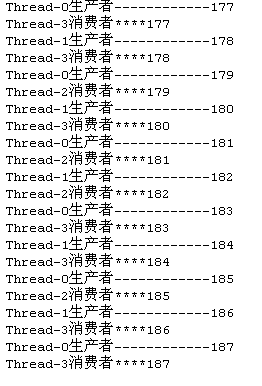
再次發現問題
打印到某個值比如生產完187,程序運行卡死了,好像鎖死了一樣。
原因分析
notify:只能喚醒一個線程,如果本方喚醒了本方,沒有意義。而且while判斷標記+notify會導致”死鎖”。
解決方案
notifyAll解決了本方線程一定會喚醒對方線程的問題。
最后代碼改進(Resource中的 notify() -> notifyAll())
Resource.java
package com.demo.ProducerConsumer;
/**
* 資源
* @author lixiaoxi
*
*/
public class Resource {
/*資源序號*/
private int number = 0;
/*資源標記*/
private boolean flag = false;
/**
* 生產資源
*/
public synchronized void create() {
while (flag) {//先判斷標記是否已經生產了,如果已經生產,等待消費;
try {
wait();//讓生產線程等待
} catch (InterruptedException e) {
e.printStackTrace();
}
}
number++;//生產一個
System.out.println(Thread.currentThread().getName() + "生產者------------" + number);
flag = true;//將資源標記為已經生產
notifyAll();//喚醒在等待操作資源的線程(隊列)
}
/**
* 消費資源
*/
public synchronized void destroy() {
while (!flag) {
try {
wait();
} catch (InterruptedException e) {
e.printStackTrace();
}
}
System.out.println(Thread.currentThread().getName() + "消費者****" + number);
flag = false;
notifyAll();
}
}運行結果:
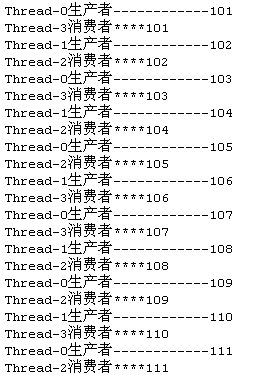
以上就大功告成了,沒有任何問題。
再來梳理一下整個流程。按照示例,生產者消費者交替運行,每次生產后都有對應的消費者,測試類創建實例,如果是生產者先運行,進入run()方法,進入create()方法,flag默認為false,number+1,生產者生產一個產品,flag置為true,同時調用notifyAll()方法,喚醒所有正在等待的線程,接下來如果還是生產者運行呢?這是flag為true,進入while循環,執行wait()方法,接下來如果是消費者運行的話,調用destroy()方法,這時flag為true,消費者購買了一次產品,隨即將flag置為false,并喚醒所有正在等待的線程。這就是一次完整的多生產者對應多消費者的問題。
三、使用Lock和Condition來解決生產者消費者問題
上面的代碼有一個問題,就是我們為了避免所有的線程都處于等待的狀態,使用了notifyAll方法來喚醒所有的線程,即notifyAll喚醒的是自己方和對方線程。如果我需要只是喚醒對方的線程,比如:生產者只能喚醒消費者的線程,消費者只能喚醒生產者的線程。
在jdk1.5當中為我們提供了多線程的升級解決方案:
1. 將同步synchronized替換成了Lock操作。
2. 將Object中的wait,notify,notifyAll方法替換成了Condition對象。
3. 可以只喚醒對方的線程。
完整代碼:
Resource1.java
package com.demo.ProducerConsumer;
import java.util.concurrent.locks.Condition;
import java.util.concurrent.locks.Lock;
import java.util.concurrent.locks.ReentrantLock;
/**
* 資源
* @author lixiaoxi
*
*/
public class Resource1 {
/*資源序號*/
private int number = 0;
/*資源標記*/
private boolean flag = false;
private Lock lock = new ReentrantLock();
//使用lock建立生產者的condition對象
private Condition condition_pro = lock.newCondition();
//使用lock建立消費者的condition對象
private Condition condition_con = lock.newCondition();
/**
* 生產資源
*/
public void create() throws InterruptedException {
try{
lock.lock();
//先判斷標記是否已經生產了,如果已經生產,等待消費
while(flag){
//生產者等待
condition_pro.await();
}
//生產一個
number++;
System.out.println(Thread.currentThread().getName() + "生產者------------" + number);
//將資源標記為已經生產
flag = true;
//生產者生產完畢后,喚醒消費者的線程(注意這里不是signalAll)
condition_con.signal();
}finally{
lock.unlock();
}
}
/**
* 消費資源
*/
public void destroy() throws InterruptedException{
try{
lock.lock();
//先判斷標記是否已經消費了,如果已經消費,等待生產
while(!flag){
//消費者等待
condition_con.await();
}
System.out.println(Thread.currentThread().getName() + "消費者****" + number);
//將資源標記為已經消費
flag = false;
//消費者消費完畢后,喚醒生產者的線程
condition_pro.signal();
}finally{
lock.unlock();
}
}
}Producer1.java
package com.demo.ProducerConsumer;
/**
* 生產者
* @author lixiaoxi
*
*/
public class Producer1 implements Runnable{
private Resource1 resource;
public Producer1(Resource1 resource) {
this.resource = resource;
}
@Override
public void run() {
while (true) {
try {
Thread.sleep(10);
resource.create();
} catch (InterruptedException e) {
e.printStackTrace();
}
}
}
}Consumer1.java
package com.demo.ProducerConsumer;
/**
* 消費者
* @author lixiaoxi
*
*/
public class Consumer1 implements Runnable{
private Resource1 resource;
public Consumer1(Resource1 resource) {
this.resource = resource;
}
@Override
public void run() {
while (true) {
try {
Thread.sleep(10);
resource.destroy();
} catch (InterruptedException e) {
e.printStackTrace();
}
}
}
}ProducerConsumerTest1.java
package com.demo.ProducerConsumer;
public class ProducerConsumerTest1 {
public static void main(String args[]) {
Resource1 resource = new Resource1();
new Thread(new Producer1(resource)).start();//生產者線程
new Thread(new Producer1(resource)).start();//生產者線程
new Thread(new Consumer1(resource)).start();//消費者線程
new Thread(new Consumer1(resource)).start();//消費者線程
}
}運行結果:
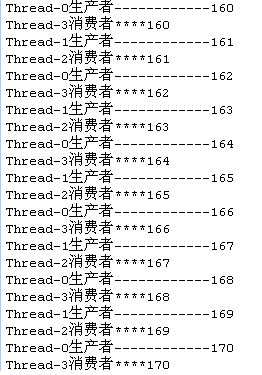
四、總結
1、如果生產者、消費者都是1個,那么flag標記可以用if判斷。這里有多個,必須用while判斷。
2、在while判斷的同時,notify函數可能喚醒本類線程(如一個消費者喚醒另一個消費者),這會導致所有消費者忙等待,程序無法繼續往下執行。使用notifyAll函數代替notify可以解決這個問題,notifyAll可以保證非本類線程被喚醒(消費者線程能喚醒生產者線程,反之也可以),解決了忙等待問題。
小心假死
生產者/消費者模型最終達到的目的是平衡生產者和消費者的處理能力,達到這個目的的過程中,并不要求只有一個生產者和一個消費者。可以多個生產者對應多個消費者,可以一個生產者對應一個消費者,可以多個生產者對應一個消費者。
假死就發生在上面三種場景下。假死指的是全部線程都進入了WAITING狀態,那么程序就不再執行任何業務功能了,整個項目呈現停滯狀態。
比方說有生產者A和生產者B,緩沖區由于空了,消費者處于WAITING。生產者B處于WAITING,生產者A被消費者通知生產,生產者A生產出來的產品本應該通知消費者,結果通知了生產者B,生產者B被喚醒,發現緩沖區滿了,于是繼續WAITING。至此,兩個生產者線程處于WAITING,消費者處于WAITING,系統假死。
上面的分析可以看出,假死出現的原因是因為notify的是同類,所以非單生產者/單消費者的場景,可以采取兩種方法解決這個問題:
(1)synchronized用notifyAll()喚醒所有線程、ReentrantLock用signalAll()喚醒所有線程。
(2)用ReentrantLock定義兩個Condition,一個表示生產者的Condition,一個表示消費者的Condition,喚醒的時候調用相應的Condition的signal()方法就可以了。
Java的特點有哪些 1.Java語言作為靜態面向對象編程語言的代表,實現了面向對象理論,允許程序員以優雅的思維方式進行復雜的編程。 2.Java具有簡單性、面向對象、分布式、安全性、平臺獨立與可移植性、動態性等特點。 3.使用Java可以編寫桌面應用程序、Web應用程序、分布式系統和嵌入式系統應用程序等。
關于“Java多線程并發生產者消費者設計模式的示例分析”這篇文章就分享到這里了,希望以上內容可以對大家有一定的幫助,使各位可以學到更多知識,如果覺得文章不錯,請把它分享出去讓更多的人看到。
免責聲明:本站發布的內容(圖片、視頻和文字)以原創、轉載和分享為主,文章觀點不代表本網站立場,如果涉及侵權請聯系站長郵箱:is@yisu.com進行舉報,并提供相關證據,一經查實,將立刻刪除涉嫌侵權內容。